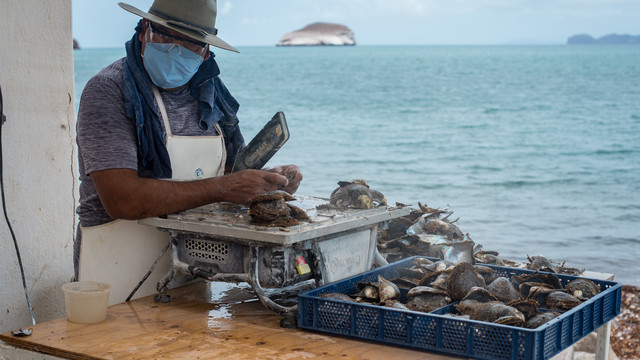It is time to control fishing on the high seas to protect the life of the ocean and coastal people who depend on it
As the state of the ocean continues to grab headlines, World Oceans Day (8 June) is an opportunity to make sure new measures to govern the high seas include fishing – the greatest threat to life in the deep ocean.


Since the 1950s, catches from the high seas, such as this one, have increased 400% (Photo: FAO)
Between mineral exploitation, pollution, climate change and overfishing, ocean life and the coastal communities in developing countries who depend on it are under threat.
According to the latest global assessment of biodiversity (PDF), fishing has had the greatest impact on life in the ocean. The high seas – the area more than 200 nautical miles from coastlines – are of particular concern.
Although they make up about half of the Earth’s surface and are home to 95% of all life (PDF), they remain largely beyond the law. But in 2018, negotiations on how to govern the high seas began, creating an opportunity to protect them.
Due to technological developments, this area is increasingly at risk. Countries that have the means are able to exploit it more –including through commercial fishing, which is heavily subsidised. Since the 1950s, catches from the high seas have increased 400%, although they have flatlined over the past decade, mainly due to overfishing. Ships from the ten richest nations, including Japan, Korea and Spain, dominate, taking more than 70% of the fish from these waters.
Extinction threat
Efforts to agree an internationally legally binding instrument to govern the high seas are in progress through the United Nations Convention on the Law of the Sea on the conservation and sustainable use of marine biological diversity of areas beyond national jurisdiction. Worryingly, these processes do not currently cover fishing.
This is in spite of the fact that these waters are crucial to the life cycles of fish stocks, their development and migration. More than 36% of migratory fish species are at risk of extinction. Tuna and other species that spend part of their lives in the high seas are particularly threatened.
To ensure the high seas have the protection they need, it is vital fishing is included in the convention that will govern it.
The frequent excuse for not doing this is that fishing is already governed by the UN Fish Stocks Agreement and regional fisheries management organisations. But these have not been effective in stopping overfishing in the high seas. One of the problems is that the regional bodies are often responsible for governing only particular species, leaving many fish stocks at risk of exploitation. They also are ineffective at monitoring and enforcing agreed regulations.
In addition to the treaty needing to include measures to control fishing, it is also important that it protects areas of the high seas that are crucial for supporting the lifecycles of fish relevant for the women, children and men who depend on them. According to joint research from IIED and the National Oceanography Centre, these are the central Indian Ocean (the Mascarene Plateau beyond national jurisdiction), the northern Bay of Bengal and the ‘high seas pockets’ of the Pacific Islands.
Despite their distance, these areas are critical for coastal communities in developing countries as they depend on small-scale fisheries for their food supply, employment and income opportunities. Unless fishing in the high seas is included in the new legally binding treaty, poor coastal fishers’ livelihoods will be at risk.
Millions of jobs for women
Fifty per cent of the world’s seafood is supplied by small-scale fisheries and more than 90% of fishers are employed at this level. And the supply chains associated with them provide millions of women with jobs.
The ongoing negotiations to establish a new legally binding global treaty to protect biodiversity on the high seas are vitally important.
We need the new instrument to protect ocean biodiversity of all kinds, to ensure that our children do not inherit an impoverished planet. But it must also be designed so it protects the livelihoods of millions of vulnerable people living in poverty who depend on marine resources for their livelihoods.
The science tells us that overfishing is the greatest threat to the future of marine life and the coastal fishers whose livelihoods depend on it. The new treaty must not duck the issue.
This blog originally appeared on the Thomson Reuters Foundation news website.




